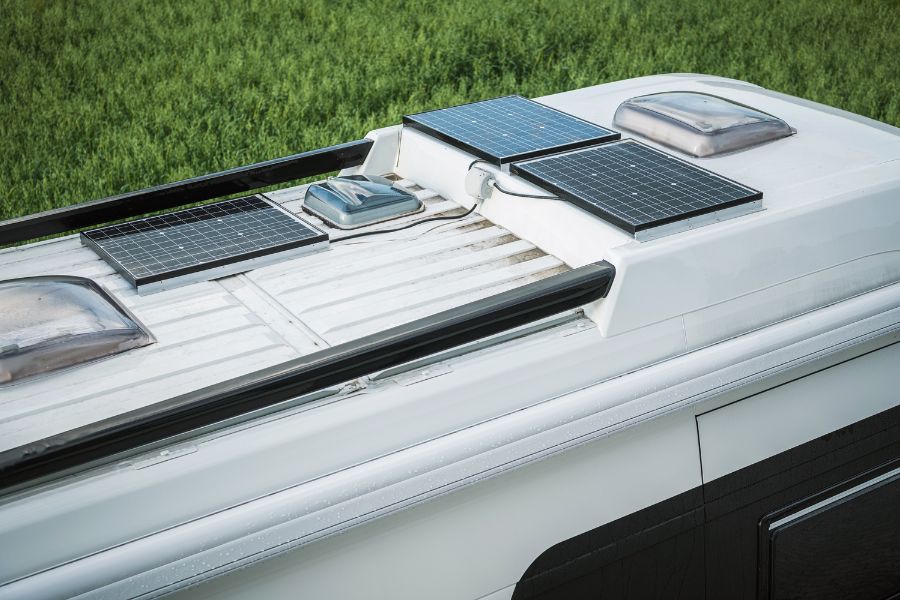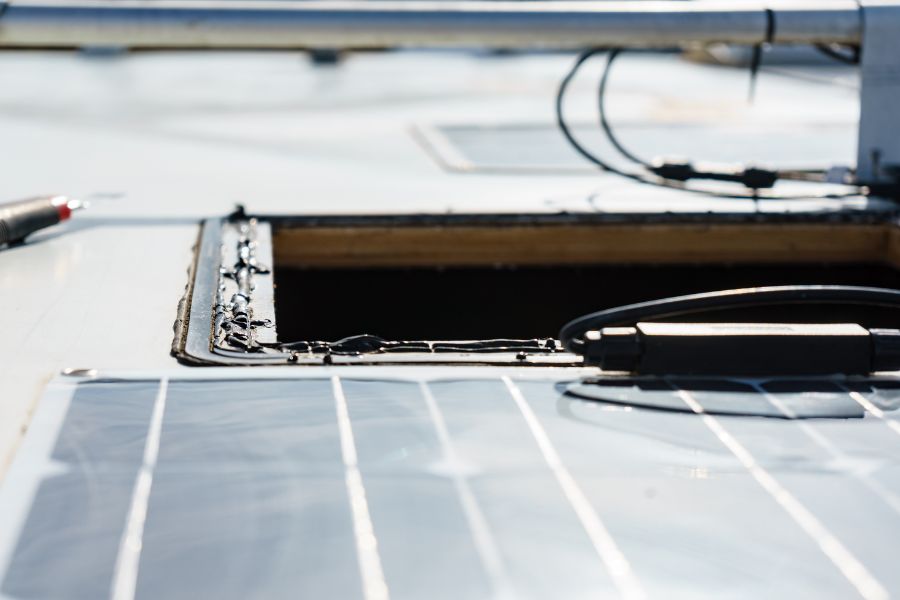RV travel has become increasingly popular among adventure seekers and nature enthusiasts. It allows you to explore breathtaking landscapes while enjoying the comforts of home on the go.
One essential aspect of an RV system is its power supply. Many RV owners are turning to solar energy as a clean, renewable, cost-effective solution to meet their power needs.
Connecting solar panels to RV batteries allows you to convert sunlight into usable electricity, which can charge your onboard battery bank and power various appliances and devices while you’re on the road or parked at a campsite.
This setup provides an eco-friendly, cost-effective alternative to running generators or relying solely on grid power hookups.
If you want to add more solar panels to your existing RV system, this blog post will guide you through the step-by-step process.
Assess Your Power Need

Before expanding your RV solar panel system by adding more solar panels, it is vital to assess your power requirements.
Start by calculating your RV appliances’ average daily energy consumption, including lights, refrigerators, water pumps, entertainment systems, and other devices you regularly use. This assessment will help determine the additional solar panels needed to meet your energy demands.
Evaluating your existing system’s energy consumption and understanding your appliances’ power needs helps you determine your solar array’s capacity.
This analysis allows you to make informed decisions about adding solar panels to your RV system, ensuring that the expanded system can generate enough electricity to power your devices and keep your batteries charged.
Remember, accurately assessing your power needs is the foundation for successfully expanding your solar panel.
Evaluate Your Current System
Selecting the right panels when adding solar panels to an existing RV solar system is paramount. Consider factors like wattage, dimensions, and compatibility with your existing panels and components.
Consider utilizing monocrystalline panels known for their high efficiency, making them a popular choice for RVs. Alternatively, flexible solar panels are lightweight, thin, and easily installed on curved surfaces.
Ensure you choose panels that align with your needs, available space, and budget.
Compatibility with your existing panels and solar system is crucial when expanding. Check the specifications of your existing solar panels and select new ones that seamlessly integrate with your current setup.
This ensures optimal performance and efficient energy generation. It’s also essential to evaluate the available space on your RV for panel installation and select panels that fit appropriately.
Though carefully selecting the right panels for your existing solar system, you can effectively expand your RV’s energy capabilities and maximize the benefits of solar power.
Choose the Right Solar Panels

Selecting the right ones is essential when adding more panels to an existing RV solar energy system. Consider factors like wattage, dimensions, and compatibility with your existing components.
Monocrystalline panels are widely recognized for their high efficiency, making them a popular choice for RVs. Additionally, flexible solar panels are lightweight, thin, and ideal for installation on curved surfaces.
Ensure that the panels you choose align with your needs, available space, and budget.
Compatibility with your existing components and array is crucial for seamless integration when expanding your RV’s solar energy system. Check the specifications of your current panels and select new ones that are compatible and can efficiently work together.
It’s also essential to assess the available space in your RV and choose panels that fit appropriately.
Consider portable panels, which offer flexibility and can be repositioned for optimal sun exposure. They can supplement your existing array and provide additional power generation.
Carefully selecting the right solar panels for your RV system expansion can enhance your energy production and maximize the benefits of solar power on your adventures.
Calculate Additional Energy Production
When planning to add more panels to an existing RV solar energy system, it is essential to calculate the increase in energy production required to meet your power needs.
Start by considering the available roof space on your RV for panel installation and the average daily sunlight hours in your travel destinations. This information will help determine the additional panels needed to generate the desired energy output.
Consult the specifications of the new solar panels to estimate the total wattage increase you can achieve. By understanding the wattage of each panel and the number of panels you plan to add, you can calculate the potential boost in energy production for your system.
Accurately calculating the additional energy production ensures that your expanded solar energy system meets your power requirements and seamlessly integrates more panels into your existing setup.
Upgrade Your Charge Controller
When adding more solar panels to your RV system, it’s important to consider upgrading your charge controller to handle the increased energy input.
The charge controller plays a crucial role in regulating the energy flow from the solar panels to your battery bank, preventing overcharging and safeguarding your batteries.
To ensure a smooth integration of additional panels into your existing array, consult a solar expert or refer to the manufacturer’s guidelines for selecting a suitable charge controller.
By upgrading your charge controller, you can effectively manage the enhanced energy production and ensure your batteries’ longevity and optimal performance. This step is crucial for maintaining the stability and efficiency of your RV solar energy system.
Whether adding more traditional panels or a portable panel to your existing array, investing in a compatible and reliable charge controller is essential. Prioritize the compatibility of your charge controller with your expanded system to make the most of your RV’s solar energy capabilities.
Expand Your Battery Bank
When expanding your existing solar panel system, it’s essential to consider increasing your battery bank’s capacity to store the additional energy generated. Evaluate the capacity of your existing batteries and determine if adding more batteries or upgrading to higher-capacity ones is necessary.
Expanding your battery bank ensures ample stored power to meet your energy needs, particularly during cloudy days or at night when solar energy production is reduced.
By assessing your existing battery capacity and making adjustments accordingly, you can enhance the overall performance and reliability of your RV solar energy systems.
A larger battery bank provides greater energy storage capabilities, allowing you to power your appliances and devices for extended periods without relying solely on solar energy generation.
Investing in an expanded battery bank maximizes the benefits of your solar panel system, ensuring a continuous and reliable power supply for your RV adventures.
Mounting the Additional Solar Panels

When adding solar panels to your RV, their mounting should be considered. Careful planning ensures that the chosen location provides ample sunlight exposure while considering factors such as aerodynamics and clearance.
Given the limited roof space typically found on RVs, creativity may be required to optimize panel placement. Utilize mounting brackets, adhesive, or other suitable methods to fasten the panels to your RV roof securely.
By strategically planning the mounting of your additional solar panels, you can maximize their energy generation potential and seamlessly integrate them into your existing solar array.
Remember to assess the available roof space to determine the number of panels you can accommodate. Efficiently securing the panels to your RV ensures their stability during travel and enables a reliable renewable energy source for your RV adventures.
Wiring and Connectivity
Proper wiring and connectivity are crucial when you add solar panels to your existing RV solar array. Use the appropriate wiring, ensuring the correct gauge and polarity for all connections.
It is advisable to consult an electrician or refer to the manufacturer’s instructions for guidance, especially if you are unfamiliar with electrical systems.
Securely connect the new solar panels to your existing system, ensuring all connections are tight and well-insulated. This prevents any electrical issues that may arise during travel. Proper wiring ensures the efficient flow of electricity from the additional solar panels to your RV’s power system.
By prioritizing the correct wiring and connectivity, you can seamlessly add solar panels to your existing system, expanding its energy-generating capabilities and reducing your reliance on other power sources.
Enjoy the benefits of a more robust and sustainable RV solar system during your travels.
Final Thoughts
Expanding your RV solar system with additional solar panels can significantly enhance your energy independence and reduce your carbon footprint.
By carefully assessing your power needs, selecting compatible components, and following the steps outlined in this blog post, you can successfully add more solar panels to your RV system.
Enjoy the freedom of renewable energy while exploring the open road and embracing the beauty of nature. Safe travels!
